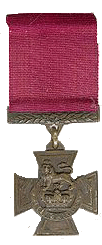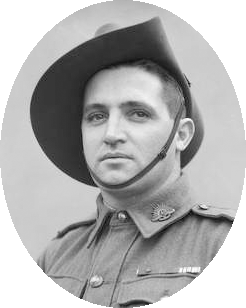Thomas Currie Derrick
Name: Tom ‘Diver’ Derrick

War: World War 2
Rank: Lieutenant
Service Number: SX7964
Units Served: 2/48th Australian Infantry Battalion.
Personal Details: Tom was born in the Salvation Army hospital on the 20th of March 1914, in the Adelaide suburb of Menindie, South Australia to David Derrick and Ada Derrick nee Whitecombe. He was the eldest child. His father was a labourer from Ireland and the family were extremely poor. Tom attended the Sturt street public school and then the Le Fevre Peninsula School for a total of 7 years until in 1928 when at the age of 14 he left to work in a bakery. Tom was described as a “bit of a larrikin” around Port Adelaide venturesome and quick-witted. Tom was very keen for sports and was fond of cricket, boxing, Aussie rules football and swimming. In particular his talent for diving earned him the nick name diver. During the depression his cheery manner found him odd jobs such as fixing bikes, selling newspapers, and working as a local baker. In the summer of 1931 after losing his job as a baker to the depression Tom and a few friends rode their bikes 225km to the riverside town of Berri in search of work. He and his two friends spent two months living in tents on the edge of the Murray River and earning a living by picking fruit such as grapes. When the Royal Adelaide show opened that year Tom went to the Boxing pavilion and accepted a challenge to stay upright for three rounds with the light weight ex-champion of Australia. Although being knocked down in the second round he quickly got back to his feet and won the bet with only a few bruised ribs and a black eye. During the end of 1931 Tom found a full time job in the town of Winkie, a small town just out of Berri. He worked picking fruit at a vineyard for nine years. On the 24th of June 1939 Tom married Clarence Violet “Beryl” Leslie. Who he described as his one true love, he met her seven years earlier at a dance. They were married at the St Laurence Catholic Church at North Adelaide.
Enlistment Details: Tom did not enlist when the war first broke out, after the falling of France in June 1940 that enlisted to the Second Australian Imperial Force on the 5th of July, 1940.
Details about his role in the War: Prior to embarking Tom was involved in basic training at Woodside. On the 17th of November 1940, Tom along with his unit the 2/48th battalion embarked Adelaide on board the SS Stratheden. This ship made a stop a Perth and Tom was told off for leaving without permission to sightsee.
On the 29th of November 1940 tom was told off again an issued a fine of 30 schilling for disorder to prejudice good order and military discipline whilst on board the ship. The unit then arrived at Palestine, on the 17th of December 1940 where the 2/48th battalion camped at el Kantra and commenced their training in the dessert. Tom was known for setting up bets on the recreational activities the soldiers were involved in when they had spare time, as it would often be Tom winning all of the events and games. On the 19th of January 1941, Tom was admitted to the Australian General Hospital for the mumps, he was released on the 28th of January. In March 1941 after extensive training, Tom and his unit travelled by train and truck to Alexandria, then to Egypt and along the north African coast to Cyrenaica in Libya to join the 9th Australian Division.
After completing their training in Cyrenaica, Toms unit was moved to Gazala. Although, just as they were setting up camp, the unit was called into Tobruk where the German Afrika Korps’ had advanced. After spending eight months in Tobruk to had regularly led fighting patrols against German and Italian troops. On April 30th Axis force invaded Tobruk and Toms leadership and bravery during the siege on the 11th of July 1941 Tom was promoted to Acting Corporal. On the 19th of October 1941 Tom was promoted to full Corporal.
In June 1942, after a period of heavy fighting the 2/48th battalion was put in reserve and Tom was promoted to Platoon Sergeant. In September 1942 the 2/48th battalion was withdrawn from Tobruk and returned to Palestine on board the HMA Kingston. On the 31st of October tom was wounded in action. On the 22nd of October the unit disembarked at Tel, Aviv.
On the 10th of July 1942, Tom and his unit took part in the first Battle of El Alamein in Egypt; they were there to reinforce the British Eighth Army. During the 26th Australian Brigade’s Attack on Tel el Eisa Tom led an attack on three machine gun posts and succeeded in destroying the positions then following on to capture 100 prisoners. Later that night when the Australian line was overrun by German tanks, Tom succeeded in destroying two tanks with Sticky Bombs. The outstanding leadership and courage displayed earned Tom the Distinguished Conduct Medal for his part in the Tel el Eisa.
On the 21st of November 1942, Tom was admitted to the 2/3rd Australian Field Ambulance with shrapnel wounds to his right hand and buttocks. On the 3rd of December Tom and his unit disembarked El Alamein and returned to Gaza in Palestine. In January 1943, the 2/48th battalion returned to Australia on Board the S.S NeiuwAmsterdam, along with the 9th division.
In late February 1943 the 2/48th Battalion disembarked Port Melbourne and Tom was granted leave. He used this time to spend with his wife Beryl. Once re-joining the 2/48th Battalion the unit went to Atherton Tableland for training in jungle warfare.
On the 4th of September 1943 Tom and his unit landed on the beaches of Papua New Guinea with the objective to fight their way 30km west towards the town Lae. On the 16th of September Lae fell to the Allies. On the 23 of November 1943 Tom became Commander of the 11th platoon of B Company. The following day the Battalion was ordered to out flank any positions in front of Satelberg. Various Attempts throughout the day failed to overpower machine gun positions. Just before the end of the day the company was ordered to withdraw, however, Tom requested one last chance to advance on the objective and he moved ahead of his own men. Tom single handily destroyed one machine gun post with a hand grenade. His men then came under fire from six different enemy posts so Tom once again risked his life by going under fire to destroy another 4 machine gun posts using hand grenades. This caused the enemy to flee. He the continued to destroy another three enemy posts using hand grenades. He single handily cleared the ground which allowed the battalion to capture Satelberg. During the siege of Finschhafen and Sattelberg Tom’s bravery and leadership earned him the Victoria Cross.
In February 1944, after fighting in Papa New Guniea, Tom and his unit returned to Australia to further train before returning to Borneo.
On the 26th of November 1944 tom was promoted to Lieutenant. On the 28th of March 1945 the unit left Cairns and arrived in Morotai on the 7th of April. The Battalion made an amphibious landing on the Borneo, and then fought towards the town of Tarakan Overcoming Japanese Resistance, throughout the next month Tom continued to fight with his battalion until the 23rd of May where he was mortally wounded at Freda.
Tom was buried at Tarakan Cemetery but was later moved to Labuan, Borneo
The 2/48th Battalion was the most decorated unit in the second world war with 4 Victoria Cross recipients and numerous DCM and MM recipients.